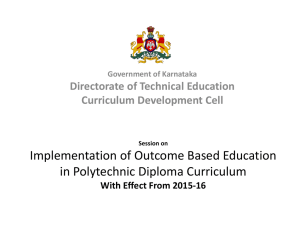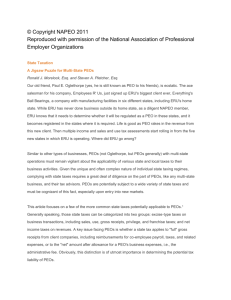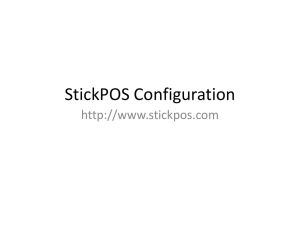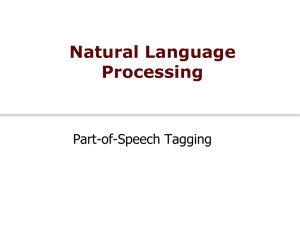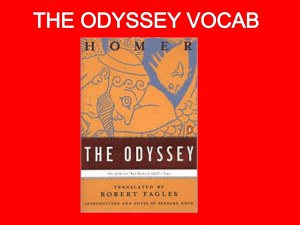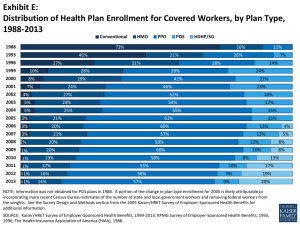OBE PPT for Polytechnics - Dept of Technical Education
advertisement
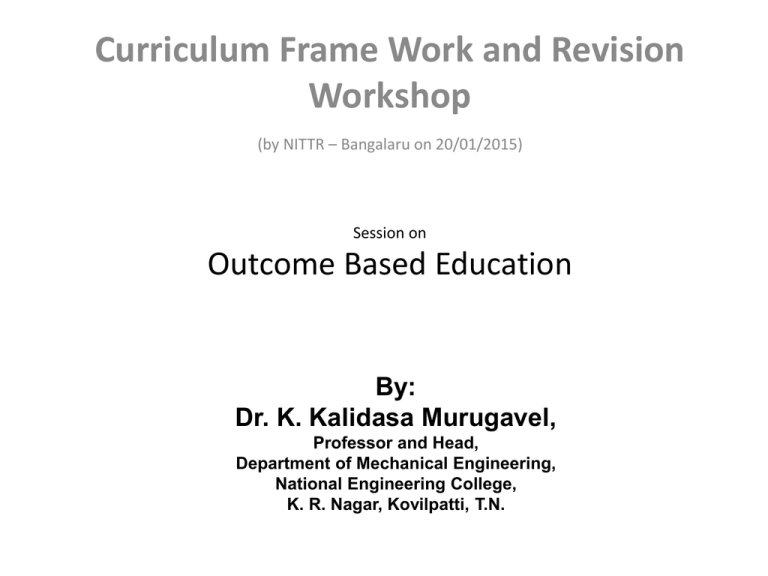
Curriculum Frame Work and Revision Workshop (by NITTR – Bangalaru on 20/01/2015) Session on Outcome Based Education By: Dr. K. Kalidasa Murugavel, Professor and Head, Department of Mechanical Engineering, National Engineering College, K. R. Nagar, Kovilpatti, T.N. Educational Models • Input-Output Model – Often involving direct prescriptions of curriculum and faculty composition – Makes the educational process uniform and potentially fair – Relatively easy to maintain – Stifle innovation and creativity in the curriculum • Outcome Model – Focuses on the objectives and outcomes of the program – Requires evidence of measurement and attainment of objectives and outcomes – Too much data may be collected and analyzed periodically Input-Output Based Education financial resources lab equipment Infrastructure facilities faculties Programm e/Instituti on Number of students graduating quantitative grades of students success rate of students Number of quality of students Measureable Input Measurable Outputs Outcome Based Education clear picture of what is important for students to be able to do… Starting with a Then organizing the curriculum, delivary and assessment to make sure learning happens… Outcome Based Education OBE (Education) OBC What the student should be able to (Curriculum) do? How to make the student achieve the (Learning & Teaching) outcome? Attributes How to measure what the student has achieved? OBLT OBA (Assessment) Key constituents of Outcome based Education Vision d e s i g n Mission Graduate Attributes Vision and Mission • Vision is a futuristic statement that the institution / department would like to achieve over a long period of time • Mission statements are essentially the means to achieve the vision • For example, – Vision: Create high-quality engineering professionals – Mission: offer a well-balanced programme of instruction, practical experience, and opportunities for overall personality development. Program Educational Objectives (PEOs) • Program educational objectives are broad statements that describe the career and professional accomplishments that the program is preparing the graduates to achieve. •Guidelines for the PEOs – – – – – PEOs should be consistent with the mission of the Institution The number of PEOs should be manageable PEOs should be achievable by the program PEOs should be specific to the program and not too broad PEOs should be based on the needs of the constituencies Graduate Attributes of the NBA for diploma programmes • Graduates Attributes (GAs) form a set of individually assessable outcomes • that are the components indicative of the diploma holders’ potential to acquire competence to practice at the appropriate level. Summary of Graduate Attributes • Engineering knowledge • Problem analysis • Design & Development of Solutions • Investigation of Problem • Modern tool usage • Engineer and society • Environment& sustainability • Ethics • Individual & team work • Communication • Lifelong learning + Project management & finance The Graduate Attributes of NBA for diploma holders • Engineering Knowledge: Apply knowledge of mathematics, science, engineering fundamentals and core engineering specialisation to the defined and applied engineering procedures, processes, systems or methodologies. • Problem Analysis: Identify, formulate, study literature, and analyse broadly-defined engineering problems in reaching substantiated conclusions using analytical tools appropriate to respective discipline or area of specialisation. . . . Graduate Attributes • Design/ Development of Solutions: Design solutions for broadly- defined engineering/technology problems and contribute to the design of systems, components or processes to meet specified needs with appropriate consideration for public health and safety, cultural, societal, and environmental considerations. • Investigations: Conduct investigations of broadly-defined problems; locate, search and select relevant data from codes, databases and literature, design and conduct experiments to provide valid conclusions. • Modern Tool Usage: Select and apply appropriate techniques, resources, and modern engineering and IT tools, including prediction and modelling, to broadlydefined engineering activities, with an understanding of the limitations. . . . Graduate Attributes • The Engineer and Society: Demonstrate understanding of the societal, health, safety, legal and cultural issues and the consequent responsibilities relevant to engineering technology practice. • Environment and Sustainability: Understand the impact of engineering/technology solutions in societal and environmental context and demonstrate knowledge of and need for sustainable development.. • Ethics: Understand and commit to professional ethics and responsibilities and norms of engineering technology practice. • Individual and Team Work: Function effectively as an individual, and as a member or leader in diverse technical teams. . . . Graduate Attributes • Communication: Communicate effectively on broadly-defined engineering activities with the engineering community and with society at large, by being able to comprehend and write effective reports and design documentation, make effective presentations, and give and receive clear instructions. • Life-long Learning: Recognise the need for, and have the ability to engage in independent and life-long learning in specialised technologies. • Project Management and Finance: Demonstrate knowledge and understanding of engineering management principles and apply the same to one’s own work as a member and leader in a team, and to manage projects in multidisciplinary environments. Broadly-defined engineering problems Broadly-defined engineering activities • A class of activities with characteristics defined in section 4.2 of the International Engineering Alliance (IEA ) Graduate Attributes and Professional Competencies v2. PEOs and Vision and Mission Example of how PEOs are linked to the Vision and Mission Vision Mission Programme Educational Objectives (PEOs) To be a leading engineering faculty for creation, preservation and dissemination of knowledge, training of knowledge workers for nation building, and providing continuous technical support for the ICT industry in Malaysia 1. To produce multi-skilled graduates who are able to spearhead nationbuilding in the Information Age 2. To provide opportunities and resources for academic and researchers to carry out the state-of-the-art research and development work 3. To support the growth of nationwide ICT industry through provision of continuous professional development of knowledge 1. To develop highly competent engineers specialising in the area of microwave and communications technologies in support of the related industry. -Related to M1,M2 & M3 2. To produce innovative technical leaders that are able to contribute towards the advancement of microwave and communications technologies. -Related to M1 & M3 18 Course, Degree, Programme, ?? • Course – Course (Subject) is a unit of teaching, which encompasses various topics, that typically lasts one semester, is led by one or more faculty and has a fixed registered students. • Programme (Electrical/Mechanical Engineering programme) – Cohesive arrangement of courses, co-cuuricular and extra-curricular activities to accomplish predetermined objectives leading to the awarding of a degree. • Degree – Academic award (Diploma) conferred upon a student on successful completion of a program designed to achieve the defined attributes II-B (2) How to Evolve Program Educational Objectives A) B) C) D) E) Consultation - Industry - Alumni - Students - Management - Professional Bodies - Faculty - Parents - Data on future - Data on trends in development in the profession - Summary of views during consultation - Accepted views - objectives - Identification and designing of courses with defined objectives. Elective and core courses. - Courses to achieve objectives Program Outcomes (POs) • Program outcomes are narrower statements that describe what students are expected to know and be able to do by the time of graduation. • Guidelines for the POs – Program outcomes basically describe knowledge, skills and behavior of students as they progress through the program as well as by the time of graduation. – POs should not be too broad – They must align with the Graduate Attributes – They must reflect all the Graduate Attributes Course Outcomes (COs) 1. Student-focused, not professor-focused That means: learning not coverage-oriented 2. Alignment between course, program, and institutional levels Course outcomes need to reflect both the objectives and coutcomes that the academic program represents as well as the broader mission of the institution as a whole 3. Focus on abilities central to the discipline Course outcomes should help prepare students for what is important to the discipline of which the course is a part 4. Focus on aspects of learning that will endure Teaching students new modes of thinking is likely to have an impact on their future; having them memorize facts tends to be much more short-lived 5. Are limited to manageable number Learning outcomes should focus a course on a few (say, 4-6) key purposes that have a realistic chance of being accomplished within a semester 6. Specific enough to be measurable 7. Blooms Taxonomy Program Specific Criteria • • • Program Criteria provide the specificity needed for interpretation of the bachelor level criteria as applicable to a given discipline. Requirements stipulated in the Program Criteria are limited to the areas of curricular topics and faculty qualifications/expertise. Example: – – CSE must include probability and statistics, discrete mathematics, mathematics through differential and integral calculus; sciences (defined as biological, social, or physical science); and engineering topics (including computing science) necessary to analyze software, and systems containing hardware and software components. ME must include Principles of engineering, basic science, and mathematics (including multivariate calculus and differential equations); to model, analyze, design, and realize physical systems, components or processes; and prepare students to work professionally in both thermal and mechanical systems areas. Publishing and disseminating Vision and Mission, PEOs, POs, COs • Awareness to all the stakeholders on the defined Vision and mission, PEOs, POs, COs – Publishing in websites, curricula books, display boards etc., – Awareness workshops to students and faculty periodically • Prepare stakeholders to reinforce with the activities vis-à-vis achievement of Vision and mission, PEOs, POs, COs How do PEOs, POs and COs relate COs ♦ ♦ ♦ GAs ♦ POs Mission PEOs Consistency between PEOs and Mission • EX: to impart quality education for the holistic development of undergraduate and graduate students with social responsibility and technically competent Key Components of Mission statements PEOs PEO1 Socially responsible Technical career …………. PEO2 PEO3 Alignment of defined POs with Graduate Attributes Program Outcomes Graduate Attributes of the NBA (a-l) a (i) Program outcome (…) (ii) Program outcome (…) …………. b c d e f g h i j k l PEO alignment with POs Program Educational Objectives Program Outcomes i (1) PEO (…) ……. ii iii iv v vi vii viii ix .. .. .. Mapping COs with POs Contribution of courses to program outcomes Type credi LAB 4 CHP01: CO1 LEC 4 MA01:CO1 LEC 4 CHT01:CO1 OTH 2 DES Course code and CO Program outcomes a b c d e f g h I j k l 4 OTH 1 OTH 2 LEC 4 Strong Contribution Week Contribution No Contribution m n Program Curriculum – Components Course Component Mathematics Science Computing Humanities Professional core ………………. ……………….. Curriculum Content (% of total number of credits of the program ) Total number of contact hours Total Number of credits POs PEOs Program Curriculum – Balance between theory and practical Balance between theory ad practice Course Code Course Title Total Number of contact hours Lectu re (L) …….. Credits Tutorial Practical# (T) (P) Total Hours ….. Total Project Name Type Achivement PO Project (….) Design Published PO 3 Project (….) Application/multi-disciplinary Prototype PO2 …….. …………… ………. ………….. Laboratory work and Project work should contribute towards outcomes Delivery method and assessment of the course is very key 31 Program Curriculum – Contributions of professional core • How the core courses are contributing to PEOS and POs • Any courses specific to meet any of the PEOS and POs • Course content contribution to meet the POs – Draft the content/syllabus in tune Design experience and engineering problem solving skills are very important Assessment methods and tools • Direct Assessment Method: using measurable performance indicators of students – – – – – – • Exams Assignments Projects Tutorials Labs Presentations Indirect Assessment Method: Ascertaining opinion or self-reports – Rubrics – Alumini survey – Employer survey – Course-end survey, etc.,. Rubric • Rubrics is set of performance indicators which define and describe the important component of the work being completed • Information to/about individual student competence (Analytic) – Communicate expectations – Diagnosis for purpose of improvement and feedback • Overall examination of the status of the performance of a group of students? (Holistic) Sample Program Outcome: Student can Work Effectively in Teams Unsatisfactory Developing 1 2 Research & Does not collect Collects very gather any information limited information relating to the topic information; some relate to the topic Fulfill team’s Does not perform Performs very roles & duties any duties assigned little duties to the team role Shares work equally Always relies on others to do the work Listen to other Is always talking; Team mates never allows anyone else to speak Satisfactory 3 Collects some basic information; most refer to the topic Performs nearly all duties Exemplary Score 4 Collects a great deal of information; all refer to the topic Performs all duties of assigned team roles Rarely does the Usually does Always does the assigned work; the assigned assigned work often needs work; rarely without having reminding needs reminding to be reminded. Usually does Listens, but most of the sometimes talk talking; rarely too much allows others to speak Listens and speaks a fair amount When to Assess Program Educational Objectives(PEOs) Few years after Graduation – 4 to 5 years Program Outcomes (POs) Upon graduation Course Outcomes (COs) Upon course completion PEO Assessment tools The data may be collected progressively Survey questions should elicit the required information Not to confirm the objective Ex. PEO: producing the graduates with leadership qualities Employer survey Q1: At which level/position our graduates (year) are working in your organization Assessment Tool (frequency) Employer satisfaction survey (Yearly) Alumni survey (Yearly). Placement records, higher education records CO Assessment tools for each course Assessment Tool End-of-course surveys Student comments Rubrics Internal Assessment and home assignment Semester end performance reports Course performance history plots PO Assessment tools for all courses Assessment Tool End-of-course surveys (Quarterly). Instructor evaluation reports (Quarterly). Department performance report (Quarterly). Student exit survey (Yearly). Alumni survey (Yearly). Alumni Advisory Board (Once or twice yearly). Student Advisory Committee (Once or twice yearly). Summary of assessment methods/tools PEOs Assessment Tool Assessment frequency Assessed by Reviewed by Employer survey Every year Institute Institute/Department Alumni survey Once or twice a Department Institute Assignments two months Faculty Faculty Examinations Semester end Faculty Faculty/Department End-of-course survey Every six months Faculty Faculty/Department Every year Institute Department Any other Every six months Department Assignments two months Faculty Faculty Examinations Semester end Faculty Faculty/Department Projects Every six Faculty Faculty/Department Any other POs Rubrics specific to PO/POs Employer survey Faculty survey COs Group tasks Assessment of the attainment of PEOs 1. PEO (..) 2. PEO (..) Assessment tool Specific query/Problem Goal (%) Evaluation(%) Industrial Survey Query (……....) 80% 85% Alumni Survey Query(…….…) ….. …. Alumni survey Query (……….) …….… … …………. ………. ……….. … Industrial Survey Query (……....) 80% 85% Alumni Survey Query(…….…) ….. …. …………. ………. ……….. … Assessment of the attainment of COs 1. CO (..) 2. CO (..) Assessment tool Specific query/Problem Goal$ (%) Evaluation(%) End examination Problem (……....) 80% 85% Rubric Query(…….…) ….. …. Alumni survey Query (……….) …….… … …………. ………. ……….. … Assignment Problem 80% 85% Industry Survey Query(…….…) ….. …. …………. ………. ……….. … (……....) Assessment of the attainment of POs • POs attainment through each Course • Direct • Indirect Administrative support for OBE • Quality Assurance cell – OBE assessment and evaluation at institutional level – Program wise assessment semester/year – Continuous improvement initiatives • Industrial/alumni advisory body – Review of the attainment of PEO,PO and suggest improvements • Program coordinator – Interacting with course coordinators towards attainment of POs and review/update the changes required for curriculum contents • Course coordinator – Assess the attainment of COs and review/update the course delivery and assessment methods Thank YOU Discussions Assignments • Establishment of vision, mission, PEO and POs for a program of the institution. • Flexibility in curriculum to meet the objectives of the program of the institution • Establishing COs for a course and correlating with POs • Delivery and Evaluation for the attainment of the CO • Project work – attainment of POs and PEOs • Soft skill development
